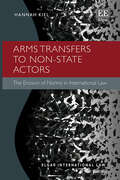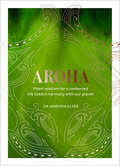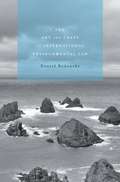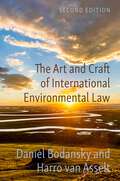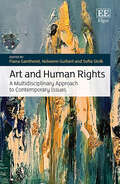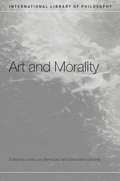- Table View
- List View
Arms Control and Disarmament Law (Elements of International Law)
by Stuart Casey-MaslenArms control and disarmament are key elements in promoting international peace and security. In recent decades the scope of disarmament law has broadened from a traditional focus on weapons of mass destruction to encompass conventional weapons. In this new volume in the Elements series, Stuart Casey-Maslen provides a concise and objective appraisal of international arms control and disarmament law. In seven concise chapters, he traces the history of arms control and disarmament in the modern era, addressing the issues surrounding biological and chemical weapons, the Non-Proliferation of Nuclear Weapons, and conventional weapon and arms transfer regimes. He concludes by considering how, in order to remain relevant, disarmament and arms control will need to adapt to rapidly evolving technologies that defy traditional means of verification and control. Arms Control and Disarmament Law is an accessible, go-to source for practicing international lawyers, judges and arbitrators, government and military officers, scholars, teachers, and students.
Arms Control and Disarmament Law (Elements of International Law)
by Stuart Casey-MaslenArms control and disarmament are key elements in promoting international peace and security. In recent decades the scope of disarmament law has broadened from a traditional focus on weapons of mass destruction to encompass conventional weapons. In this new volume in the Elements series, Stuart Casey-Maslen provides a concise and objective appraisal of international arms control and disarmament law. In seven concise chapters, he traces the history of arms control and disarmament in the modern era, addressing the issues surrounding biological and chemical weapons, the Non-Proliferation of Nuclear Weapons, and conventional weapon and arms transfer regimes. He concludes by considering how, in order to remain relevant, disarmament and arms control will need to adapt to rapidly evolving technologies that defy traditional means of verification and control. Arms Control and Disarmament Law is an accessible, go-to source for practicing international lawyers, judges and arbitrators, government and military officers, scholars, teachers, and students.
The Arms Crisis of 1970: The Plot that Never Was
by Michael HeneyThe number one Irish Times bestsellerIn 1970, Taoiseach Jack Lynch accused two cabinet ministers, Charles Haughey and Neil Blaney, of smuggling arms to the IRA in Northern Ireland. The criminal prosecution that followed was a cause célèbre at the time. All the accused were acquitted, but it generated a political crisis that would be one of the major events of modern Irish history.In the fifty years since, myth and controversy has surrounded the trial and its aftermath. Michael Heney has unearthed astonishing new evidence, raising serious questions about Lynch and his relationship with Haughey. The Arms Crisis of 1970 is the first comprehensive investigation into the arms trial prosecution, and how the jury came to their verdict of acquittal.Reviews:'An indisputable, forensic interpretation of the events of 1970... Impressive for its methodology, and is indispensable for anyone interested in what actually happened 50 years ago' Colm Tóibín, Irish Times, Books of the Year'Persuasive... A real life whodunnit written with the pace and drama of a political thriller' Eilis O'Hanlon, Irish Independent'Heney strips away the lies associated with the great Irish scandal of 1970... A ground-breaking book' Diarmaid Ferriter'Brilliant de-bunking of the myths, heroes and villains of the Arms Crisis' Mary O'Rourke, Sunday Independent
The Arms Trade and International Law (Studies in International Law)
by Zeray YihdegoShortlisted for the 2008 Young Authors Inner Temple Book PrizeThere are believed to be about 700 million small arms and light weapons (SALW) in the world, often contributing to highly destabilising security and other concerns in international law. SALW are the primary source of violations and abuses of humanitarian and human rights principles by states, rebels, terrorists and criminals. Many consider them the real weapons of mass destruction of our time, causing about half a million deaths annually. The unrestricted international transfer of SALW by states (99 states and 1000 companies involved in manufacturing and supply) is one of the major contributory and aggravating factors of this crisis; another is the illicit traffic in small arms. This book deals with the proliferation of SALW and their unregulated trade and transfer across borders. It addresses questions of definition, manufacturing, trade/transfer, and issues relating to state responsibility. The primary focus is on conventional small arms, in particular military-style weapons. The book tackles the core and most divisive legal problem of whether or not the laws relating to arms control and relevant norms of international law provide substantive restrictions upon the transfer of small arms by states. The application of the norms of international peace and security, non-intervention, humanitarian and human rights laws, and evolved relevant customary rules of arms control relating to these norms are considered particularly carefully. Questions of application and enforcement of relevant rules and institutional responses to the problem are also examined. The UN began considering an arms trade treaty in 2006; the publication of the book at this critical moment in time will make a positive contribution towards shaping the debate and aims to further enhance understanding in an area where close analysis is required.
The Arms Trade Treaty: A Commentary (Oxford Commentaries on International Law)
by Andrew Clapham Stuart Casey-Maslen Gilles Giacca Sarah ParkerThe United Nations Arms Trade Treaty became binding international law in late 2014, and although the text of the treaty is a relatively concise framework for assessing whether to authorize or deny proposed conventional weapons transfers by States Parties, there exists controversy as to the meaning of certain key provisions. Furthermore, the treaty requires a national regulatory body to authorize proposed transfers of conventional weapons covered by the treaty, but does not detail how such a body should be established and how it should effectively function. The Arms Trade Treaty: A Commentary explains in detail each of the treaty provisions, the parameters for prohibitions or the denial of transfers, international cooperation and assistance, and implementation obligations and mechanisms. As states ratify and implement the Treaty over the next few years, the commentary provides invaluable guidance to government officials, commentators, and scholars on the meaning of its contentious provisions. This volume describes in detail which weapons are covered by the treaty and explains the different forms of transfer that the Arms Trade Treaty regulates. It covers international human rights, trade, disarmament, humanitarian law, criminal law, and state-to-state use of force, as well as the application of the treaty to non-state actors.
The Arms Trade Treaty: A Commentary (Oxford Commentaries on International Law)
by Andrew Clapham Stuart Casey-Maslen Sarah Parker Gilles GiaccaThe United Nations Arms Trade Treaty became binding international law in late 2014, and although the text of the treaty is a relatively concise framework for assessing whether to authorize or deny proposed conventional weapons transfers by States Parties, there exists controversy as to the meaning of certain key provisions. Furthermore, the treaty requires a national regulatory body to authorize proposed transfers of conventional weapons covered by the treaty, but does not detail how such a body should be established and how it should effectively function. The Arms Trade Treaty: A Commentary explains in detail each of the treaty provisions, the parameters for prohibitions or the denial of transfers, international cooperation and assistance, and implementation obligations and mechanisms. As states ratify and implement the Treaty over the next few years, the commentary provides invaluable guidance to government officials, commentators, and scholars on the meaning of its contentious provisions. This volume describes in detail which weapons are covered by the treaty and explains the different forms of transfer that the Arms Trade Treaty regulates. It covers international human rights, trade, disarmament, humanitarian law, criminal law, and state-to-state use of force, as well as the application of the treaty to non-state actors.
Arms Transfers to Non-State Actors: The Erosion of Norms in International Law (Elgar International Law series)
by Hannah KielThis insightful book analyses the issue of norm erosion in international law by examining arms transfers to non-state actors. Balancing empirical research with legal theory, the author dissects recent case studies, tracing individual changes in norms against a background of systemic transformation.Arms Transfers to Non-State Actors follows changes in the prohibition of arms transfers to non-state actors since the pivotal International Court of Justice's Nicaragua ruling in 1986. Hannah Kiel critically discusses the legal developments through relevant case studies, including Abkhazia, Bosnia, Congo, Eastern Ukraine, Kosovo, Libya, Northern Iraq, South Ossetia, Syria and Yemen. Adopting a customary law perspective while also placing the narratives of states in the context of international structural changes, Kiel emphasises the interplay between state practice and the strengthening of a human rights-based paradigm. Kiel ultimately shows that changes in norms at the individual level indicate a larger transformation in the international order, and while the arming of non-state actors remains formally illegal, the prohibition of this practice is informally eroding.Interdisciplinary in scope, this book provides valuable insights for scholars and researchers of public international law, human rights, international humanitarian law, and international relations. It is also of great benefit to human rights lawyers, policymakers, and diplomats.
Aroha: Maori wisdom for a contented life lived in harmony with our planet
by Hinemoa ElderAncient wisdom for difficult modern timesKia oraWelcome to Aroha.Aroha is an ancient Maori word and way of thinking that means love, compassion, respect and empathy. Discover how we can all find greater contentment and kindness for ourselves, each other and our world with more Aroha in our lives.Through 52 whatatauki - traditional Maori life lessons - Maori psychiatrist Dr Hinemoa Elder shares the power of Aroha and explores how it could help us all every day.Family, community, a sense of place, looking after each other, living in tune with the natural world are all fundamental to traditional Maori culture. Aroha gives the All Blacks pride, unity and heart. It is understandable that New Zealand Prime Minister Jacinda Ardern chose to call her daughter Neve Te Aroha.The 52 life lessons are arranged into 4 chapters that introduce the different, important facets of Aroha: Manaakitanga (kindness); Kaitiakitanga (love for our world); Whanaungatanga (empathy); and Tino rangatiratanga (what is right).Respected Maori psychiatrist Dr Hinemoa Elder offers a uniquely insightful perspective that can help us all in our daily lives.Ki te kotahi te kakaho ka whati, ki te kapuia, e kore e whati.When we stand alone we are vulnerable but together we are unbreakable.
Around the World in 80 Species: Exploring the Business of Extinction
by Jill Atkins Barry AtkinsThe world is currently experiencing a sixth period of mass species extinction, and extinction of flora and fauna is caused by a variety of factors arising from industrial activity and increasing human population, such as global warming, climate change, habitat loss, pollution and use of pesticides. Most causes of extinction are linked to corporate activity, either directly or indirectly. Around the World in 80 Species: Exploring the Business of Extinction responds to the ongoing mass extinction crisis engulfing our planet by exploring the ways in which accounting, business and finance can be used to prevent species extinctions. From Africa to the Far East and from Europe to the Americas, the authors explore species loss and how businesses can stop mass extinctions through greater transparency, and through closer engagement with their investors and wildlife organisations. The book concludes that global capitalism has led us to this extinction crisis and that therefore the mechanisms of capitalism – namely accounting, finance, investment – can help to pull us out. Businesses must urgently address extinction before it is too late for all species, including ourselves. As the first book to explore corporate accounting and accountability in relation to species on the brink of extinction, this book will be of great interest to both professionals and a wider audience interested in the causes and prevention of extinction.
Around the World in 80 Species: Exploring the Business of Extinction
by Jill Atkins Barry AtkinsThe world is currently experiencing a sixth period of mass species extinction, and extinction of flora and fauna is caused by a variety of factors arising from industrial activity and increasing human population, such as global warming, climate change, habitat loss, pollution and use of pesticides. Most causes of extinction are linked to corporate activity, either directly or indirectly. Around the World in 80 Species: Exploring the Business of Extinction responds to the ongoing mass extinction crisis engulfing our planet by exploring the ways in which accounting, business and finance can be used to prevent species extinctions. From Africa to the Far East and from Europe to the Americas, the authors explore species loss and how businesses can stop mass extinctions through greater transparency, and through closer engagement with their investors and wildlife organisations. The book concludes that global capitalism has led us to this extinction crisis and that therefore the mechanisms of capitalism – namely accounting, finance, investment – can help to pull us out. Businesses must urgently address extinction before it is too late for all species, including ourselves. As the first book to explore corporate accounting and accountability in relation to species on the brink of extinction, this book will be of great interest to both professionals and a wider audience interested in the causes and prevention of extinction.
The Arrest Conventions: International Enforcement of Maritime Claims
by Paul MyburghThe Arrest Conventions, signed in 1952 and 1999, play a fundamental role in the worldwide enforcement of maritime claims. Arrest of ships is one of the most distinctive features of international maritime law. It provides a powerful, efficient and effective means of enforcing maritime claims in rem, obtaining sufficient asset security and preserving property pending substantive proceedings. Ship arrest is, however, also a draconian power that cuts across property rights and can cause considerable commercial harm to shipowning interests. This book provides thematic and comparative analysis from leading international commentators on the most significant legal and policy issues, including practical problems arising from the Arrest Convention texts, as well as the direct implementation or indirect 'translation' of the Arrest Conventions into domestic legal systems. It critically analyses the political and historical development of the Conventions, explores the key concepts underpinning the Arrest Convention frameworks and considers the future of ship arrest.
The Arrest Conventions: International Enforcement of Maritime Claims
The Arrest Conventions, signed in 1952 and 1999, play a fundamental role in the worldwide enforcement of maritime claims. Arrest of ships is one of the most distinctive features of international maritime law. It provides a powerful, efficient and effective means of enforcing maritime claims in rem, obtaining sufficient asset security and preserving property pending substantive proceedings. Ship arrest is, however, also a draconian power that cuts across property rights and can cause considerable commercial harm to shipowning interests. This book provides thematic and comparative analysis from leading international commentators on the most significant legal and policy issues, including practical problems arising from the Arrest Convention texts, as well as the direct implementation or indirect 'translation' of the Arrest Conventions into domestic legal systems. It critically analyses the political and historical development of the Conventions, explores the key concepts underpinning the Arrest Convention frameworks and considers the future of ship arrest.
Arrest, Detention, and Criminal Justice System: A Study in the Context of the Constitution of India
by B. Uma DeviA just, fair, reasonable, and purposeful exercise of arrest and detention powers by the State is both in the interest of the individual and the society at large. However, very often individual rights are impinged by arbitrary and illegal exercise of State power to arrest and detain. The book studies issues pertaining to arrest and detention, comprehensively, critically, and analytically, in the light of the Indian Constitution. It points out that the arrest and detention provisions in the legal system of India, by and large, have remained the same as inherited from the imperial British era. Despite constitutional prescriptions and judicial pronouncements over several decades, there has been no noteworthy change that would bring the law in tune with the constitutional emphasis on right to life and personal liberty as well as other human rights. To capture the complexity of the issue, the volume analyses constitutional provisions, statutory law, pertinent judgments, case law, reports of various committees, and recommendations of experts in the field. Exploring lacunae in the present legal scenario, the book stresses on the need for organizational and attitudinal changes in the State instrumentalities for successfully balancing the need to maintain law and order and human rights imperatives. Emphasizing that it is the poor who often suffer the most, the author further advocates inclusion of the developments in the field of jurisprudence, behavioural sciences, technology, and management to deal with crime and criminality.
Arriving Where We Started: Aristotle and Business Ethics (Issues in Business Ethics #51)
by Edwin M. HartmanEdwin Hartman offers an account of his intellectual journey from Aristotle to organization theory to business ethics to an Aristotelian approach to business ethics. Aristotle’s work in metaphysics and psychology offers some insights into the explanation of behavior. Central to this sort of explanation is characteristically human rationality. Central to successful organizations is characteristically human sociability. That human beings are by nature rational and sociable is the basis of Aristotle’s ethics. Though a modern organization is not a polis in Aristotle’s sense, it has good reason to treat people as rational and sociable on the whole, and thereby to preserve the organization as a commons of people linked by something much like Aristotle’s account of strong friendship. Organizations that are successful in this respect, particularly those that deal with a nationally diverse workforce, may offer a far-reaching and attractive model.
Art and Copyright
by Simon StokesFirst published in 2001, Art and Copyright has established itself as a leading text in the field. Revised and updated, this third edition includes additional coverage of the following topics:- The relationship between designs law and artistic works;- EU and Brexit developments;- AI-created works;- graffiti and other non-conventional works;- blockchain and rights management;- orphan works;- new exceptions to copyright; and- digital copyright, art databases and online platforms.This book remains an invaluable work for all those involved in art law and for intellectual property lawyers involved with the exploitation and/or sale of artistic works, as well as for intellectual property academics, researchers, law students, curators, publishers, artists, gallery owners, auction houses, and those developing and running online art platforms, databases and technology to transact in art.
Art and Copyright
by Simon StokesFirst published in 2001, Art and Copyright has established itself as a leading text in the field. Revised and updated, this third edition includes additional coverage of the following topics:- The relationship between designs law and artistic works;- EU and Brexit developments;- AI-created works;- graffiti and other non-conventional works;- blockchain and rights management;- orphan works;- new exceptions to copyright; and- digital copyright, art databases and online platforms.This book remains an invaluable work for all those involved in art law and for intellectual property lawyers involved with the exploitation and/or sale of artistic works, as well as for intellectual property academics, researchers, law students, curators, publishers, artists, gallery owners, auction houses, and those developing and running online art platforms, databases and technology to transact in art.
The Art and Craft of International Environmental Law
by Daniel BodanskyInternational environmental law is often closer to home than we know, affecting the food we eat, the products we buy, and even the air we breathe. Drawing on more than two decades of experience as a government negotiator, consultant, and academic, Daniel Bodansky brings a real-world perspective on the processes by which international environmental law develops, and influences the behavior of state and non-state actors.
The Art and Craft of International Environmental Law
by Daniel Bodansky Harro van AsseltIn countless ways we are affected by international environmental norms: some social, others legal; some quite general, others very specific. For example, the norms limiting the refrigerants used in air conditioners have been agreed upon in legal form internationally, and are mandated and enforced by national governments. The sustainable fishery and forestry standards used by Carrefour and Ikea were developed more informally by environmental groups and businesses, and are applied to producers through supply-chain contracts, without any government involvement. The reluctance to eat tuna fish or own elephant ivory reflects more general social norms, disseminated through education and culture. How and why do these norms arise? In what ways do they affect behavior? Do they change what states and individuals actually do and, if so, why? How effective are they in solving international environmental problems? In the second edition of The Art and Craft of International Environmental Law, Daniel Bodansky and Harro van Asselt explore these and other questions. Revisions cover the numerous developments spanning the 13 years since the first edition was published. New chapters address the growing role of environmental NGOs and the increasingly complex architecture of environmental law involving multiple institutions, levels of governance, and actors. Recent research has been incorporated on treaty design and policy implementation and effectiveness, and greater attention has been given to the role of the judiciary in standard-setting, implementation, and enforcement. A sophisticated yet highly readable introduction to how international environmental law works (and sometimes doesn't work), this book is essential reading for a wide audience.
The Art and Craft of Policy Advising: A Practical Guide
by David BromellThis book offers a practical guide for policy advisors and their managers, grounded in the author’s extensive experience as a senior policy practitioner in central and local government. Effective policy advising does not proceed in ‘cycles’ or neatly ordered ‘stages’ and ‘steps’, but is first and foremost a relationship built on careful listening, knowing one’s place in the constitutional scheme of things, becoming useful and winning the confidence of decision makers. The author introduces readers to a public value approach to policy advising that uses collective thinking to address complex policy problems; evidence-informed policy analysis that factors in emotions and values; and the practice of ‘gifting and gaining’ (rather than ‘trade-offs’) in collaborative governing for the long term. Theory is balanced with practical illustration and processes, tools and techniques, helping readers master the art of communicating what decision-makers need to hear, as well as what they want to hear.
The Art and Craft of Policy Advising: A Practical Guide
by David BromellThis book offers a practical guide for policy advisors and their managers, grounded in the author’s extensive experience as a senior policy practitioner in New Zealand’s Westminster-style system of government. A key message is that effective policy advising is less about cycles, stages and steps, and more about relationships, integrity and communication. Policy making is incremental social problem solving. Policy advising is mostly learned on the job, like an apprenticeship. It starts with careful listening, knowing one’s place in the constitutional scheme of things, winning the confidence of decision makers, skillfully communicating what they need to hear and not only what they want to hear, and learning to lead from behind, scheme virtuously and play nicely with others. The author introduces a public value approach to policy advising that uses collective thinking to address complex policy problems, evidence-informed policy analysis that also factors in emotions and values, and the practice of “gifting and gaining” (rather than “trade-offs”) in the long-term public interest. Theory is illustrated by personal anecdote and each chapter offers practical processes, tools, techniques and questions for reflection, to help readers master the art and craft of policy advising. This second edition has been substantially revised and updated. It provides an expanded, step-by-step approach to stakeholder analysis and prioritisation in relation to an agency’s own strategic frame; it aligns and integrates theory about the public interest, public value and anticipatory governance; and it updates a “fair go” multi-criteria decision analysis matrix with the latest iteration of the N.Z. Treasury’s Living Standards Framework.
Art and Ethics in a Material World: Kant’s Pragmatist Legacy (Routledge Studies in Ethics and Moral Theory)
by Jennifer A McMahonIn this book, McMahon argues that a reading of Kant’s body of work in the light of a pragmatist theory of meaning and language (which arguably is a Kantian legacy) leads one to put community reception ahead of individual reception in the order of aesthetic relations. A core premise of the book is that neo-pragmatism draws attention to an otherwise overlooked aspect of Kant’s "Critique of Aesthetic Judgment," and this is the conception of community which it sets forth. While offering an interpretation of Kant’s aesthetic theory, the book focuses on the implications of Kant’s third critique for contemporary art. McMahon draws upon Kant and his legacy in pragmatist theories of meaning and language to argue that aesthetic judgment is a version of moral judgment: a way to cultivate attitudes conducive to community, which plays a pivotal role in the evolution of language, meaning, and knowledge.
Art and Ethics in a Material World: Kant’s Pragmatist Legacy (Routledge Studies in Ethics and Moral Theory)
by Jennifer A McMahonIn this book, McMahon argues that a reading of Kant’s body of work in the light of a pragmatist theory of meaning and language (which arguably is a Kantian legacy) leads one to put community reception ahead of individual reception in the order of aesthetic relations. A core premise of the book is that neo-pragmatism draws attention to an otherwise overlooked aspect of Kant’s "Critique of Aesthetic Judgment," and this is the conception of community which it sets forth. While offering an interpretation of Kant’s aesthetic theory, the book focuses on the implications of Kant’s third critique for contemporary art. McMahon draws upon Kant and his legacy in pragmatist theories of meaning and language to argue that aesthetic judgment is a version of moral judgment: a way to cultivate attitudes conducive to community, which plays a pivotal role in the evolution of language, meaning, and knowledge.
Art and Human Rights: A Multidisciplinary Approach to Contemporary Issues
This timely book builds bridges between the notions of art and aesthetics, human rights, universality, and dignity. It explores a world in which art and justice enter a discussion to answer questions such as: can art translate the human experience? How does humanity link individuality and community building? How do human beings define and look for their identity? The fields of human rights and art are brought together in order to open the discussion and contribute to the promotion and protection of human rights.This interdisciplinary book brings together experts in the fields of art, cultural heritage, social justice, human rights, international law, and transitional justice, and presents the idea that a complex interplay between morality, politics, law, and aesthetics remains present in concrete settings such as the rights of cultural creators, the right to artistic expression, art as a catalyst of change in times of conflict, and post-conflict restitutions. The book offers vignettes of current debates in art and human rights, tackling issues at the confluence of these fields by providing a general framework upon which the conversation can be built, and by bringing to the discussion a diverse range of contemporary themes and concrete case analyses.This book will be an ideal read for academics interested in international law, transitional justice and human rights. Historians, lawyers, artists, and activists looking to explore the relationship between art and human rights in times of war, peace, and transition through their assessment of contemporary issues will also benefit from this comprehensive book.
Art and Morality
by José Luis Bermúdez Sebastian GardnerFeaturing contributions from Matthew Kieran, Aaron Ridley, Roger Scruton and Mary Mothersill to name but a few, this collection of groundbreaking new papers on aesthetics and ethics, highlights the link between the two subjects. These leading figures tackle the important questions that arise when one thinks about the moral dimensions of art and the aesthetic dimension of moral life.The volume is a significant contribution to philosophical literature, opening up unexplored questions and shedding new light on more traditional debates in aesthetics. The topics explored include:the relation of aesthetic to ethical judgment the relation of artistic experience to moral consciousnessthe moral status of fictionthe concepts of sentimentality and decadencethe moral dimension of critical practice, pictorial art and musicthe moral significance of tragedythe connections between artistic and moral issues elaborated in the writings of central figures in modern philosophy, such as Kant, Schopenhauer and Nietzsche.The contributors share the view that progress in aesthetics requires detailed study of the practice of criticism. This volume will appeal to both the philosophical community and to researchers in areas such as literary theory, musicology and the theory of art.
Art and Morality (International Library Of Philosophy Ser.)
by Sebastian GardnerFeaturing contributions from Matthew Kieran, Aaron Ridley, Roger Scruton and Mary Mothersill to name but a few, this collection of groundbreaking new papers on aesthetics and ethics, highlights the link between the two subjects. These leading figures tackle the important questions that arise when one thinks about the moral dimensions of art and the aesthetic dimension of moral life.The volume is a significant contribution to philosophical literature, opening up unexplored questions and shedding new light on more traditional debates in aesthetics. The topics explored include:the relation of aesthetic to ethical judgment the relation of artistic experience to moral consciousnessthe moral status of fictionthe concepts of sentimentality and decadencethe moral dimension of critical practice, pictorial art and musicthe moral significance of tragedythe connections between artistic and moral issues elaborated in the writings of central figures in modern philosophy, such as Kant, Schopenhauer and Nietzsche.The contributors share the view that progress in aesthetics requires detailed study of the practice of criticism. This volume will appeal to both the philosophical community and to researchers in areas such as literary theory, musicology and the theory of art.




